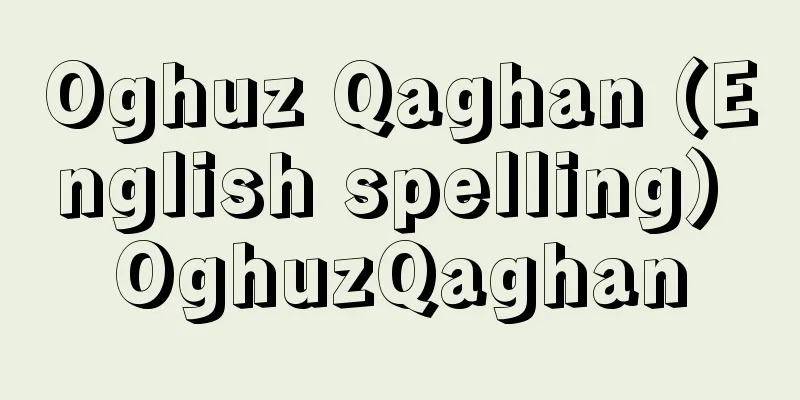Fault - danso (English spelling) fault

|
A rock breaks along a certain plane, causing the blocks on either side to displace relatively along the plane. The broken plane is called a fault plane, and the movement that creates the fault is called fault movement. In general, a displacement that can only be confirmed under a microscope is not called a fault. [Tanio Itoh and Akihiro Murata, February 17, 2016] Classification of faults based on the direction of displacementFaults are classified according to the direction of displacement, regardless of the magnitude of the displacement. When displacement occurs in the direction of the dip of the fault plane, they are classified as (1) normal faults, (2) reverse faults, or (3) thrust faults. When displacement occurs in the direction of the strike of the fault plane, they are called strike-slip faults, and are classified as (4) right-lateral strike-slip faults or (5) left-lateral strike-slip faults. (1) A normal fault is a fault in which, when the fault plane is inclined, the upper block of the fault (the hanging wall) slides down relative to the lower block (the footwall). (2) A reverse fault is a fault with a fault plane that is inclined at an angle of 45 degrees or more and in which the upper block slides upward relative to the lower block. (3) A thrust fault is a fault whose fault plane is inclined at 45 degrees or less and has the same displacement as a reverse fault. When the fault plane is inclined at 45 degrees, either a reverse fault or a thrust fault can be used. In a reverse fault, the vertical displacement component is greater than the horizontal displacement component, while in a thrust fault, the horizontal displacement component is greater. (4) A right-lateral strike-slip fault is a fault in which the block on the other side of the fault moves to the right. In other words, a right-lateral strike-slip fault is a fault in which a block on the other side of a fault moves to the right. (5) A left-lateral strike-slip fault is one in which the block on the other side of the fault moves to the left. The fault plane of a strike-slip fault is often vertical or very steeply dipping. Faults are basically classified into the above five types, but in reality, there are many oblique-slip faults, which have displacement in a direction oblique to both the dip and strike of the fault plane. In such cases, rather than simply calling them oblique-slip faults, they are often expressed as "left-lateral strike-slip faults with reverse fault components" or "left-lateral strike-slip reverse faults." The former is used when left-lateral strike-slip motion is predominant, and the latter when reverse fault motion is predominant. The Nojima Fault, which showed displacement on the ground surface during the Southern Hyogo Prefecture Earthquake (Great Hanshin-Awaji Earthquake), had a right-lateral strike-slip component of 2 meters and a reverse fault component of 1 meter, so it is a right-lateral strike-slip fault with a reverse fault component. When the displacements along a fault are not always parallel, but rotate in opposite directions in the blocks on either side, the fault is called a hinge fault. When the dominant displacement along a hinge fault is in the dip direction, the fault may change from a normal fault to a reverse fault. [Tanio Itoh and Akihiro Murata, February 17, 2016] Faulting and fault zonesGenerally, one fault movement does not necessarily form a single fault plane; two or more fault planes may form in close proximity at the same time. Fault movements often occur repeatedly. In this way, many fault planes are formed closely together within a certain width. This is called a fault zone. In fault zones, the crushing of rocks progresses, and various shapes of fractured rocks are formed. The area where fractures are concentrated is called the fault fracture zone. When a fault runs through a soft covering layer near the surface or unconsolidated sediments under the seabed, fracture hardly occurs and only a fault surface is formed as a discontinuous surface. At depths slightly deeper than near the surface, rocks are crushed into angular gravel, and fault breccia is formed in the fault zone. When fracture progresses and the grain size is reduced to approximately clay-size (about 4 micrometers or less), unconsolidated fault gouge is formed. Fault gouge was once called fault clay, but is no longer called that. At greater depths, the crushed breccia and fine-grained material solidify to form cataclasite. At depths of several kilometers to 10 kilometers or more underground, fault movement causes fluidization accompanied by recrystallization, forming mylonite. It is also known that frictional heat caused by rapid fault movement can melt rocks and form pseudotachylyte veins. In fault zones, fractures formed at different depths often overlap. On fault surfaces, "scratches" caused by fault movement can appear as thin lines. These are called striations, and provide valuable information about the direction of fault displacement. When a fault surface is smooth enough to have a glossy appearance, it is called a "mirror surface." [Tanio Itoh and Akihiro Murata, February 17, 2016] Deformation of the Earth's surface due to faultsEarthquakes are a type of fault movement. When a shallow earthquake reaches a magnitude of 6.5 or more, the fault reaches the earth's surface and deforms it. If there is vertical displacement, a corresponding difference in height occurs, forming a fault scarp. When fault movement occurs repeatedly, the fault scarp gradually grows and eventually forms a large fault scarp. If the strike-slip displacement is large, depressions and small protuberances are created along the fault, and mountain ridges and rivers are bent. However, these landforms are only formed in their pure form when erosion and sedimentation are relatively weak compared to fault movement; in places like Japan, where erosion and sedimentation are both intense, the deformation of the earth's surface due to fault movement is more complex. [Tanio Itoh and Akihiro Murata, February 17, 2016] [Reference items] | | | | | | |Fracture©Shogakukan "> Major types of faults and axes of maximum compressive stress A fault in a layer from the early Quaternary Period of the Cenozoic Era. The left side is slipping relatively along the normal fault (far right in the photo), while the right side is slipping relatively along the reverse fault (upper left in the photo). Tateyama City, Chiba Prefecture ©Shogakukan "> Normal and reverse faults Source: Shogakukan Encyclopedia Nipponica About Encyclopedia Nipponica Information | Legend |
|
岩石がある面に沿って破断し、両側のブロックblock(地塊)が面に沿って相対的に変位したもの。破断した面を断層面、断層を生ずる運動を断層運動とよぶ。一般には、顕微鏡下でのみ変位が確認できる規模のものは断層とはいわない。 [伊藤谷生・村田明広 2016年2月17日] 変位の向きによる断層の分類断層は、変位の大小にかかわらず、変位の向きによって分類される。断層面の傾斜方向に変位が生じた場合は、(1)正断層、(2)逆断層、(3)衝上(しょうじょう)断層の三つに分類される。断層面の走向方向に変位が生じた場合は横ずれ断層とよばれ、(4)右横ずれ断層と、(5)左横ずれ断層に分類される。 (1)正断層は、断層面が傾斜しているとき、断層の上側のブロック(上盤(うわばん))が下側のブロック(下盤(したばん))に対して、相対的にずり落ちる変位をもつ断層である。 (2)逆断層は、断層面が45度以上に傾斜した断層で、上側のブロックが下側のブロックに対して、相対的にずり上がる変位をもつ断層である。 (3)衝上断層は、断層面が45度以下に傾斜した断層で、逆断層と同じ向きの変位をもつ断層である。なお、断層面の傾斜が45度の場合には、逆断層、衝上断層のどちらを用いてもよい。逆断層では水平方向よりも上下方向の変位成分が大きく、衝上断層では逆に水平方向の変位成分が大きい。 (4)右横ずれ断層は、断層を挟んで向こう側のブロックが右に移動したものである。別の表現をすると、断層をまたいだとき、またいだ先のブロックが右に移動したものが右横ずれ断層である。 (5)左横ずれ断層は、断層を挟んで向こう側のブロックが左に移動したものである。横ずれ断層の断層面は、垂直であるか、または非常に急傾斜であることが多い。 断層は、基本的には前記五つに分類されるが、実際には、断層面の傾斜、走向のいずれとも斜交した方向の変位をもつ、斜めずれ断層が多い。このような場合は、単に斜めずれ断層とよぶよりも、「逆断層成分をもつ左横ずれ断層」とか、「左横ずれ逆断層」のように表現されることが多い。なお、前者は左横ずれ運動が主で、後者は逆断層運動が主であるときの表現である。兵庫県南部地震(阪神・淡路大震災)で地表に変位が現れた野島断層は、右横ずれ成分が2メートル、逆断層成分が1メートルであったので、逆断層成分をもつ右横ずれ断層となる。 断層による変位はどの位置でも平行であるとは限らず、両側のブロックで反対方向に回転している場合は、蝶番断層(ちょうつがいだんそう)とよばれる。蝶番断層で、主要な変位が傾斜方向であるとき、正断層から逆断層に移り変わる場合がある。 [伊藤谷生・村田明広 2016年2月17日] 断層運動による破砕と断層帯一般に、1回の断層運動に伴って一つの断層面が形成されるとは限らず、同時に二つ以上の断層面が近接して生ずることがある。また断層運動は、しばしば繰り返しおこることが多い。こうして、多くの断層面がある幅の間に密集して形成される。これを断層帯とよぶ。 断層帯においては、岩石の粉砕が進行し、それに伴ってさまざまな形状の破砕岩が形成される。破砕が集中する部分を断層破砕帯という。地表近くの軟らかい被覆層や、水底下の未固結の堆積(たいせき)物の中を断層が走る場合、破砕はほとんどおこらず不連続面としての断層面のみが形成される。地表近くよりもやや深い場合は、岩石は角張った礫(れき)状に破砕され、断層角礫が断層帯に形成される。破砕が進行して粒径がおよそ粘土サイズ(約4マイクロメートル以下)にまで細粒化されると、未固結の断層ガウジfault gougeが形成される。断層ガウジは、かつて断層粘土とよばれたことがあるが、現在ではよばない。さらに深くなると、破砕した角礫や細粒物質が固結し、カタクレーサイトが形成される。地下数キロメートルないし10キロメートル以深になると、断層運動によって、再結晶を伴う流動化がおこりマイロナイトが形成される。また、急激な断層運動による摩擦熱で岩石が溶融し、シュードタキライトの脈が形成されることも知られている。断層帯においては、さまざまな深さで形成された破砕が重複していることが多い。 断層面上には、断層運動に伴う「ひっかき傷」が細い筋(すじ)として刻印されていることがある。これを条線とよび、断層変位の向きを知る有力な情報となる。また断層面が光沢をもつほど滑らかな場合は鏡肌(かがみはだ)という。 [伊藤谷生・村田明広 2016年2月17日] 断層による地表の変形地震は断層運動の一つである。直下型地震のマグニチュードが6.5程度以上になると、断層は地表に到達し地表を変形させる。垂直変位が存在する場合は、それに相当する高度差が生じ、断層崖(だんそうがい)を形成する。繰り返し断層運動がおこると、断層崖はしだいに成長し、やがて大きな断層崖を形成する。横ずれ変位が大きい場合は、断層に沿って凹地や小隆起がつくられたり、山稜(さんりょう)・河川などの屈曲がおこる。しかしこれらの地形が純粋な形で形成されるのは、侵食作用や堆積作用が断層運動に対して相対的に弱い場合であって、日本のように侵食・堆積作用とも激しい所では、断層運動に伴う地表の変形はもっと複雑である。 [伊藤谷生・村田明広 2016年2月17日] [参照項目] | | | | | | | |©Shogakukan"> おもな断層の種類と最大圧縮応力の軸 新生代第四紀初期の地層中の断層。正断層(写真右端)に沿っては左側が、逆断層(写真左上)に沿っては右側が、それぞれ相対的にずり落ちている。千葉県館山市©Shogakukan"> 正断層と逆断層 出典 小学館 日本大百科全書(ニッポニカ)日本大百科全書(ニッポニカ)について 情報 | 凡例 |
Recommend
Kaigetsudo Beauty - Kaigetsudo Beauty
…Unusually for an ukiyo-e artist, he specialized ...
Cocaine hydrochloride
…It can also be chemically synthesized. Cocaine h...
Ziryene
…It is a language of the Finnic group of the Finn...
Drobeta-Turnu Severin (English)
…The capital of Mehedinci County. Its official na...
Yellow phosphorus (Phosphorus)
An allotrope of phosphorus. Pure phosphorus is col...
Arber, W.
...Since strain C does not have either of these f...
Return of Light - Return of Light
A Chinese scholar of classical literature in the ...
Ibogawa [town] - Ibogawa
A former town in Ibo County in the southwest of Hy...
Akemi Ide
⇒ Tachibana Akemi Source: The Selected Edition of ...
Red Wallaroo - Red Wallaroo
...Their bodies are sturdier than those of wallab...
Sir Roderick Impey Murchison
British geologist. Born in Ross-shire (now Ross a...
Pula (English spelling)
Pola in Italian. A port city located at the southe...
phase space
...An important point about the canonical form is...
Crassostrea gigas (English spelling)
… [Cultivated oysters] Oyster farming is popular ...
Arletty
May 15, 1898 - July 23, 1992 French film actress....



![Okutama [town] - Okutama](/upload/images/67cb1b947d123.webp)





